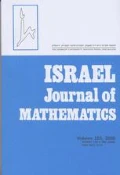Abstract
Geometric grid classes and the substitution decomposition have both been shown to be fundamental in the understanding of the structure of permutation classes. In particular, these are the two main tools in the recent classification of permutation classes of growth rate less than κ ≈ 2.20557 (a specific algebraic integer at which infinite antichains first appear). Using language- and order-theoretic methods, we prove that the substitution closures of geometric grid classes are well partially ordered, finitely based, and that all their subclasses have algebraic generating functions. We go on to show that the inflation of a geometric grid class by a strongly rational class is well partially ordered, and that all its subclasses have rational generating functions. This latter fact allows us to conclude that every permutation class with growth rate less than κ has a rational generating function. This bound is tight as there are permutation classes with growth rate κ which have nonrational generating functions.
Similar content being viewed by others
References
M. H. Albert and M. D. Atkinson, Simple permutations and pattern restricted permutations, Discrete Mathematics 300 (2005), 1–15.
M. H. Albert, M. D. Atkinson, M. Bouvel, N. Ruškuc and V. Vatter, Geometric grid classes of permutations, Transactions of the American Mathematical Society 365 (2013), 5859–5881.
M. H. Albert, M. D. Atkinson and N. Ruškuc, Regular closed sets of permutations, Theoretical Computer Science 306 (2003), 85–100.
M. H. Albert, M. D. Atkinson and V. Vatter, Subclasses of the separable permutations, Bulletin of the London Mathematical Society 43 (2011), 859–870.
M. H. Albert and S. Linton, Growing at a perfect speed, Combinatorics, Probability and Computing 18 (2009), 301–308.
J. Balogh, B. Bollobás and R. Morris, Hereditary properties of ordered graphs, in Topics in Discrete Mathematics, Algorithms and Combinatorics, Vol. 26, Springer, Berlin, 2006, pp. 179–213.
R. Brignall, Wreath products of permutation classes, Electronic Journal of Combinatorics 14 (2007), Research paper 46, 15 pp.
R. Brignall, S. Huczynska and V. Vatter, Simple permutations and algebraic generating functions, Journal of Combinatorial Theory. Series A 115 (2008), 423–441.
M. Elder and V. Vatter, Problems and conjectures presented at the Third International Conference on Permutation Patterns, University of Florida, March 7–11, 2005, arXiv:math.CO/0505504.
P. Flajolet and R. Sedgewick, Analytic Combinatorics, Cambridge University Press, Cambridge, 2009.
J. Gustedt, Finiteness theorems for graphs and posets obtained by compositions, Order 15 (1999), 203–220.
L. H. Haines, On free monoids partially ordered by embedding, Journal of Combinatorial Theory 6 (1969), 94–98.
G. Higman, Ordering by divisibility in abstract algebras, Proceedings of the London Mathematical Society 2 (1952), 326–336.
J. E. Hopcroft, R. Motwani and J. D. Ullman, Introduction to Automata Theory, Languages, and Computation, 2nd ed., Addison-Wesley Publishing Co., Reading, MA, 2001.
S. Huczynska and V. Vatter, Grid classes and the Fibonacci dichotomy for restricted permutations, Electronic Journal of Combinatorics 13 (2006), R54, 14 pp.
M. Klazar, Overview of some general results in combinatorial enumeration, in Permutation Patterns, London Mathematical Society Lecture Note Series, Vol. 376, Cambridge University Press, 2010, pp. 3–40.
J. B. Kruskal, Well-quasi-ordering, the Tree Theorem, and Vazsonyi’s conjecture, Transactions of the American Mathematical Society 95 (1960), 210–225.
A. Marcus and G. Tardos, Excluded permutation matrices and the Stanley-Wilf conjecture, Journal of Combinatorial Theory. Series A 107 (2004), 153–160.
C. St. J. A. Nash-Williams, On well-quasi-ordering finite trees, Proceedings of the Cambridge Philosophical Society 59 (1963), 833–835.
J. Noonan and D. Zeilberger, The enumeration of permutations with a prescribed number of “forbidden” patterns, Advances in Applied Mathematics 17 (1996), 381–407.
V. R. Pratt, Computing permutations with double-ended queues, parallel stacks and parallel queues, in Fifth Annual ACM Symposium on the Theory of Computing (Austin, TX, 1973), Association for Computing Machinery, New York, 1973, pp. 268–277.
J. H. Schmerl and W. T. Trotter, Critically indecomposable partially ordered sets, graphs, tournaments and other binary relational structures, Discrete Mathematics 113 (1993), 191–205.
V. Vatter, Permutation classes of every growth rate above 2.48188, Mathematika 56 (2010), 182–192.
V. Vatter, Small permutation classes, Proceedings of the London Mathematical Society 103 (2011), 879–921.
Author information
Authors and Affiliations
Corresponding author
Additional information
All three authors were partially supported by EPSRC via the grant EP/J006440/1.
Vatter’s research was sponsored by the National Security Agency under Grant Number H98230-12-1-0207. The United States Government is authorized to reproduce and distribute reprints notwithstanding any copyright notation herein.
Rights and permissions
About this article
Cite this article
Albert, M.H., Ruškuc, N. & Vatter, V. Inflations of geometric grid classes of permutations. Isr. J. Math. 205, 73–108 (2015). https://doi.org/10.1007/s11856-014-1098-8
Received:
Revised:
Published:
Issue Date:
DOI: https://doi.org/10.1007/s11856-014-1098-8



